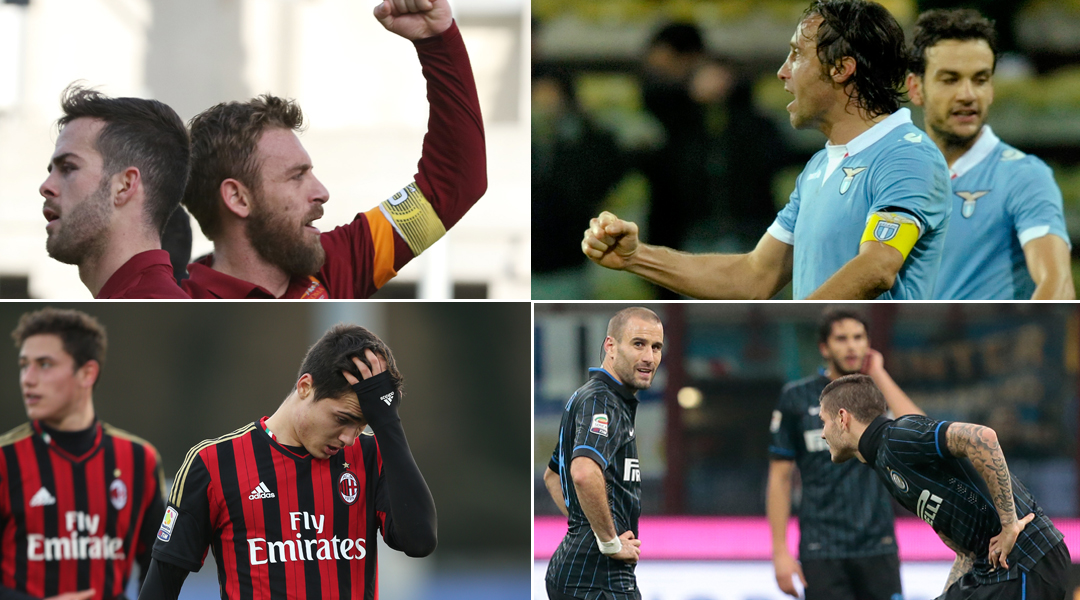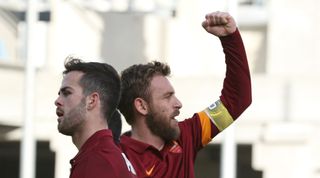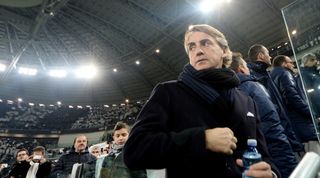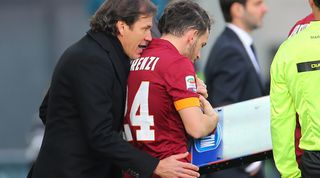Rome booms as Milan falls in Italian power-shift
Second-placed Roma face third-placed Lazio this weekend. The Italian capital is awakening just as the Milanese slumber, says Greg Lea...

In 1871, a decade after the unification of Italy, Rome was made capital of the fledgling state. The country’s government had previously been based in Florence, but when Napoleon’s forces were finally expelled after the outbreak of the Franco-Prussian War, control of Italy moved to Rome.
That same year, 900 miles away in London, English football’s governing body launched the FA Cup, a competition that went on to consolidate early interest in the game and led 17 years later to the introduction of a professional league.
Romans probably wish that the latter of those events had taken place 50 years or so before the former. Had that been the case, the sport would surely have come to the peninsula earlier than the final few years of the 19th Century, and footballing as well as political power may have shifted southwards to Rome in 1871.
As it turned out, the northern cities established an early stranglehold that they have yet to relinquish. Since the inaugural scudetto in 1898, teams from Italy's capital have won only five championships, with Turin on 37, Milan 36 and Genoa 10.
There have, however, been signs this season that calcio’s northern oligopoly may be under threat. The city of Genoa hasn't been a force in almost a century, the city’s outfits Sampdoria and Genoa winning only one title between them since the early 1920s. Turin, meanwhile, continues to dominate purely through the 30-scudetti might of Juventus, who have broken numerous records on their way to the last three leagues titles.

A glance at the current Serie A table though, reveals an interesting situation: AC Milan and Inter, the sides from Italy’s second city, sit seventh and 11th respectively.
For the first time in 13 years, neither San Siro side qualified for this season’s Champions League; should they both miss out on next season's primary continental competition, as looks likely, it would be the first time that has happened since the mid-80s, when only one team per country competed in the old European Cup unless they were defending the title itself.
Get FourFourTwo Newsletter
The best features, fun and footballing quizzes, straight to your inbox every week.
The health of the capital’s clubs could not be more different. After Serie A’s midweek action, Roma moved within a point of Juventus at the top and Lazio convincingly brushed aside Sampdoria to remain in third. It is still early days, of course, and Roma and Lazio may fall away before May, but ahead of the Rome derby this Sunday, there are definite signs of a power shift in Italian football.
Milanese malaise
The decline of the Milan clubs is attributable to a number of different factors. Italy has been particularly affected by the global economic downturn, and Serie A has not escaped the effects.
Cost-cutting meant Inter and Milan sold Zlatan Ibrahimovic, Thiago Silva, Samuel Eto’o, Wesley Sneijder, Thiago Motta and others, while the move towards a more collectively-bargained television deal has also seen the two giants’ revenue take a hit.
Despite such external factors, Inter and Milan are also partly responsible for their own downfall. Roberto Mancini is the Nerazzurri’s sixth manager since Jose Mourinho departed in 2010, each coach bringing in their own players and implementing a new tactical style, only to be dismissed a few months later.

Milan have shown slightly more patience – Clarence Seedorf would probably disagree, but his predecessor Max Allegri was given three-and-a-half seasons – yet have also been harmed by a lack of cohesion within the club. Owner Silvio Berlusconi has taken a slightly more hands-off approach over the last few years, with his daughter Barbara stepping into the role of Deputy Chief Executive.
Unfortunately for Rossoneri unity, she and Adriano Galliani, the CEO responsible for much of the day-to-day running of the club, have fundamentally divergent beliefs regarding the direction the club should take. As Milan slumped to eighth in 2013/14, the pair were more likely to be producing public pot-shots at each other than providing leadership off the field.
Roman advances
Milan’s slump has been Rome’s gain. Juventus, Inter and Milan are traditionally the big three of Italian football, lifting 66 scudetti between them, but the Milanese malaise has left Juve short of serious challengers. On this season’s evidence, Lazio and Roma are the teams most likely.
Roma continue to go from strength to strength under manager Rudi Garcia. In the three seasons before the Frenchman's arrival in summer 2013 the Giallorossi had finished sixth, seventh and sixth, showing little sign challenging for the Champions League places anytime soon.
Garcia’s impact was instant, however, as Roma flew out of the traps last season, winning their first 10 games and losing only 5 all season. Juventus proved too strong in the end, but Roma pushed them all the way and finished second, comfortably ahead of Napoli.

It's no surprise that things have continued in the same vein in 2014/15. Garcia and sporting director Walter Sabatini have assembled a strong squad with impressive depth, and on their day Roma are capable of playing some of the best football in Europe.
Francesco Totti remains influential even at 38; Gervinho is a different player to the erratic and inconsistent one seen at Arsenal; Kostas Manolas has been a revelation at centre-back; and Miralem Pjanic, Radja Nainggolan, Seydou Keita, Kevin Strootman and Daniele De Rossi provide superb midfield options.
FEATURE "Africa's Messi" Gervinho goes from Arsenal gloom to Roma glory
Whereas the Milanese outfits represent stagnation, underachievement and reactive management, Roma are a great example of an Italian club going places. Italian football has been relatively slow to attract the kind of overseas investment that has stimulated other leagues across the continent, but Roma’s American owner James Pallotta is the perfect advert for the benefits such foreign involvement can bring.
The new breed
Pallotta, despite being of Italian descent, has not been affected by the malaise surrounding the game on the peninsula. Pre-season tours of the USA have helped increase support for Roma in the States, while the organisation of a reality TV show in China that offers talented youngsters the chance to train with the Giallorossi’s youth team is evidence of Pallotta’s awareness of the importance of emerging footballing markets in today’s globalised world, something that other Serie A clubs have been slow to cotton on to.
Plans for a new stadium are afoot too, which would help Roma to enormously increase their revenue, particularly in relation to the vast majority of Italian clubs – including Milan and Inter – who do not privately own their homes. This, perhaps even more than a title triumph, could really help Roma challenge the big boys on a permanent basis.
Much praise is also being lavished on Lazio at present. Three wins in their last four games has lifted Stefano Pioli’s men into Italy's third and final Champions League spot. Captain Antonio Candreva and Brazilian trickster Felipe Anderson have caught the eye, but the likes of Lucas Biglia, Marco Parolo and Stefan de Vrij have also had excellent seasons so far.
TALENTSPOTTER Meet Neymar's former partner in crime who's setting Serie A alight

Owner Claudio Lotito’s appointment of Pioli now looks a masterstroke. After his two-and-a-half mixed years at Bologna, Pioli was questioned by some, but he has done brilliantly at moulding some fine individuals into a strong collective force.
Napoli are breathing down the Biancocelesti’s necks, but if Lazio can get through games with Roma, Milan and Rafa Benitez’s side without too much damage, they have a favourable run of fixtures in February and March.
Lotito and the fans may have repeatedly clashed over the years, but an increased sense of togetherness in recent months could provide the platform for a return to the Champions League.
Rome vs Milan
Lazio and Roma haven't both finished in the top three since 2007; that was an impressive accomplishment, even though neither came close to troubling champions Inter. Roma’s title victory in 2000/01 was the last occasion when both they and Lazio ended a season above the Nerazzurri and Milan, although normal service was resumed over the next few years.
Indeed, there is a clear difference between a temporary upturn and sustained, long-term success, and the capital duo should not be tricked into thinking that Milan and Inter will be in the doldrums indefinitely.
Nevertheless, while there are still 63 more points to play for in Serie A, it cannot be denied that the Roman clubs are enjoying fantastic campaigns. Milan has the history and tradition, but with its clubs on the wane, Lazio and Roma look primed to step into the breach should they continue to falter.
The city of Rome will be going to battle this Sunday afternoon but, 144 years after it was made the political centre of Italy, there is a feeling that Lazio and Roma could be about to change the country’s footballing landscape together.
Preview, follow and analyse Roma vs Lazio with Stats Zone
Greg Lea is a freelance football journalist who's filled in wherever FourFourTwo needs him since 2014. He became a Crystal Palace fan after watching a 1-0 loss to Port Vale in 1998, and once got on the scoresheet in a primary school game against Wilfried Zaha's Whitehorse Manor (an own goal in an 8-0 defeat).
